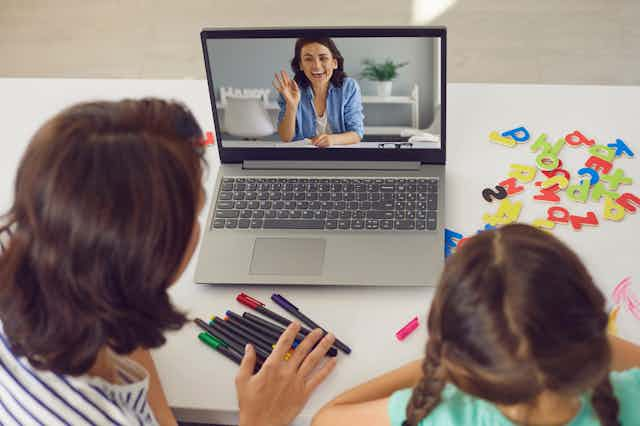When the first wave of COVID-19 reached England, the national lockdown led to school closures with very little warning for pupils, teachers and parents. Children’s homes became their classrooms.
We carried out research into primary school teachers’ experiences of remote learning during the first and second COVID lockdowns. This involved an online survey of 271 teachers from schools across England and interviews with teachers from 24 schools in June and July 2020. We then conducted follow-up interviews with 14 of the teachers in April 2021, after the second period of school closures.
In particular, we looked at the relationship between teachers and parents. School closures resulted in a dramatic shift in the role that parents were required to play in their children’s learning. Teachers’ expectations of parents shifted from supporting learning at home, based on what children were doing at school, to being integrally involved in schooling at home.
Helping families
Our research sheds light on the obstacles that parents and teachers faced, but also the effective strategies that teachers used to get parents involved with their children’s learning.
School closures exacerbated the “digital divide” between families who had good access to technology and digital skills, and those who did not. Disadvantaged children and families were less likely to have sufficient technology and internet access for remote learning, compared with their more affluent counterparts. Some parents and children only had internet access through a smartphone rather than a tablet or computer, which was often impractical for remote learning.
The UK government set up a scheme to allocate digital devices to families who needed them, but the teachers we spoke to told us that attempts to provide devices to families were not always effective. Schools often had very few devices available compared with the number of pupils in need, and teachers also reported that devices quickly became damaged.
In some cases, parents were unwilling to take laptops home – for example, one teacher commented:
We had about 29 (laptops). In the end most families didn’t want one. We actually gave out about four of the 29 – possibly because if you’ve got a computer, then you need to be doing the learning.
For some families, additional barriers such as work commitments and other children at home prevented them engaging in home learning.
During the first lockdown, the teachers we spoke to wanted to prioritise the wellbeing of families and children, rather than adding to the pressure families were facing with demands for schooling at home. As one teacher noted, “We have said to families, just having experiences like cooking at home or gardening, these are all equally as valuable.” Another told us:
I sent out [letters] about parents not putting themselves under pressure about the amount and quality of work their child should be submitting each week. I had quite a number of emails from some parents saying: ‘Oh my goodness, you don’t know how much that letter meant to me when I read it. I’ve been putting myself under so much pressure. I was really worried about this.’
Under pressure
The mood had shifted by the second period of school closures. When we interviewed teachers again, government requirements for remote and in-person teaching during school closures had increased considerably. One teacher explained:
The government told us that we had to do exactly what we would have been doing in class. And we had to provide four hours of good-quality teaching and learning every day. That’s what people could expect.
This created stress for teachers in providing sufficient materials, and for parents in keeping up with the learning, particularly as more parents were back working in the second period of closures.
Teachers told us they worked with parents to build their digital skills and increase their confidence when helping their children with schoolwork. This included running online workshops and providing short videos to introduce parents to key concepts and teaching methods.

Greater communication between teachers and parents during the school closures also led to stronger relationships. One deputy headteacher observed:
Getting to know the parents at a deeper level… we actually sort of moved further on in the relationships, and trust really helped… I think we built more (trust).
Gaining insight into children’s home lives also allowed schools to provide additional support where it was needed most. One teacher told us their school sent out hampers of food and other essential items to families.
Technology can provide valuable opportunities for connecting parents with their children’s schooling. However, unless there are greater efforts to tackle the digital divide, increasing use of technology will put the most vulnerable children at a greater disadvantage. Overall, the experiences of the teachers we spoke to during lockdown show that parents and teachers can play a mutually supportive role in children’s education, in the pandemic and beyond.

